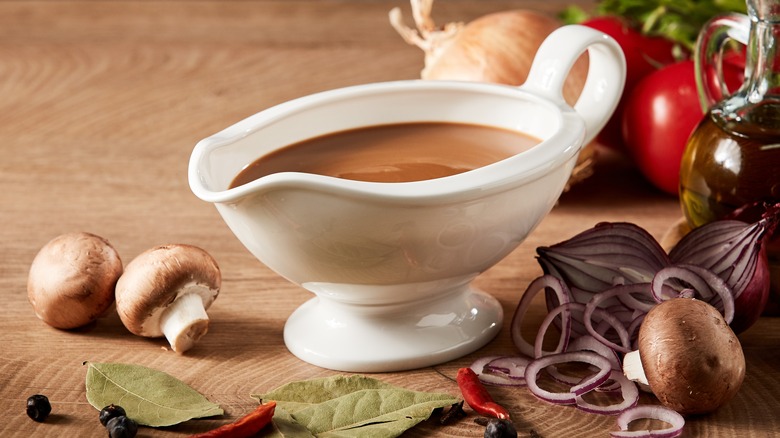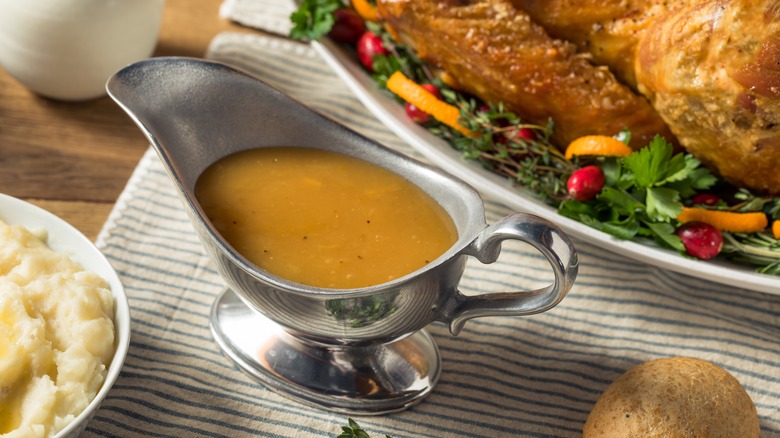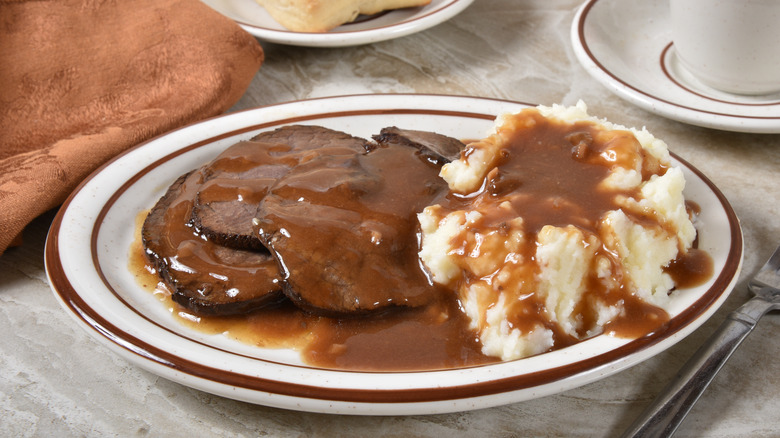A Fast, Easy Fix To Rescue Greasy Gravy
Mashed potatoes, biscuits, turkey, and sausage: what do these four foods have in common? The answer is that all four dishes usually include gravy in some form, whether it's country gravy poured on top of sausage and biscuits or gravy poured over potatoes and turkey.
One of the reasons gravy is such a common sight at dinner tables across the country — aside from it being delicious — is that it's remarkably easy to make. Whenever you make chicken, beef, pork, or turkey, you're usually left with pan drippings. It's these pan drippings that are mixed with flour and liquids such as stocks, wine, or butter in order to make gravy. While gravy can benefit from the addition of herbs and seasonings, such as KFC's famous brown gravy, a simple gravy made of drippings and flour is more than enough to make even the driest piece of meat moist and flavorful again.
Although the recipe for gravy is simple, it's also surprisingly easy to make a mistake when making it. Rather than making a gravy that's thick and smooth, you could wind up making a gravy that looks and tastes more like hot grease than a rich sauce. It looks thin and watery, and seems to only add a salty, oily taste to whatever you're putting it on. At first glance, it seems like all that work going into making your gravy has been for nothing, but there's actually one ingredient you can add to fix it.
You should add a bit of cornstarch to rethicken gravy
Aside from an undercooked turkey or chicken, nothing ruins a good hearty dinner more than greasy gravy. Instead of enjoying a juicy and tender piece of poultry served up with a savory and thick gravy, you're fishing your chicken or turkey from a pool of oily gravy.
Fortunately, you needn't worry. In fact, the one ingredient you need to fix it is something you've already used when you were making the gravy. Simply take half a teaspoon of cornstarch and mix it with one teaspoon of water until a fine slurry forms. Take this slurry and slowly pour it into the gravy, mixing slowly but steadily as you pour it in. The cornstarch will help to "bind" with the excess grease and fat, thus allowing some body to come back into the pan drippings.
Of course, depending on how thick your gravy is, you may need to add more cornstarch to get the right consistency. This trick is also very useful as a general thickening agent. If you were to find yourself with gravy that's too thin for your liking, you can add some cornstarch and water to help thicken it up a bit. But what should you do if your gravy becomes both greasy and watery at once? What is this phenomena called and how do you fix it?
What would happen if your gravy breaks?
If you have oily gravy that's also strangely watery, you may have "broken sauce" — or in this case, broken gravy. Broken sauce refers to when the sauce or gravy "breaks" into two separate liquids: the fatty, oily film on the surface and the thin, greasy, liquid below it. This can happen for a variety of reasons, such as the sauce or gravy being too hot or too much fat being added too quickly.
To fix broken gravy, all you need to do is add more liquid, whether it's milk or cream, and continue to whisk until the gravy begins to recombine. A good rule of thumb is "the thicker, the better"— adding emulsifiers such as butter, flour, or heavy cream are very good for helping to "rebuild" broken gravy. Since broken gravy refers to when the fats have separated from the liquid part, anything that's used to add body or thicken a dish can help save it.
If your gravy isn't too thin, greasy, or watery, but is instead too thick, then all you have to do is add water or stock until the gravy begins to thin out. While cornstarch and flour can help hold a gravy together and thicken it, a few teaspoons of water can help thin the consistency of otherwise thick, rubbery gravy. When it comes to gravy, it's a careful balance of thickening and thinning agents that ensure the best topping for dinner.


